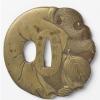
Geraint
Members-
Posts
3,086 -
Joined
-
Last visited
-
Days Won
9
Geraint last won the day on August 17 2022
Geraint had the most liked content!
Contact Methods
-
Website URL
https://www.instagram.com/geraintwilton/
Profile Information
-
Gender
Male
-
Location:
Cornwall UK
-
Interests
Long time collector of Japanese swords and associated items.
Profile Fields
-
Name
Geraint
Recent Profile Visitors
8,764 profile views
Geraint's Achievements
-
Dear Sky. If you are studying Myoju then can I recommend Art and the Sword vol. 5 and 6 by the JSS/US? From that volume: 'Myoju was born during the first year of Eiroku (1558) as the second son of Shigetaka, the grandson of the 23rd generation Sanjo Munechika.' Sadly a little later in the same article by Kataoka Ginsaku ther is the following, 'However this family lineage is absolutely unreliable.' By western academic standards this is frustrating, we tend to assume that records exist and that they are to be trusted. But we are dealing with a society that understands lineage as significant but possibly open to creation when required. A comparable example is the oft quoted Myochin family tree which is now regarded as largely fictitious. If you want to assume the first bit of information is correct then there you are, however it would perhaps be better to hold that idea lightly. Hope that helps but in any case I do commend any and all of the volumes of Art and the Sword to you as excellent resources. All the best.
-
Dear Craig. Just to add to Brian's assessment the very slender and poorly formed 'habaki' are someone's half hearted attempt at DIY. Both blades are Japanese but I think both have been cobbled together with assorted fittings to run them into complete swords. Your photographs don't allow a detailed response but the shape of the tsuka and the wrap on the second look suspect. However if my sons had done this for me I would be very happy so don't let anything spoil that. All the best.
-
Dear All. I realise that these are not to everyone's taste but I have just picked this one up and thought some might be interested. 69mm by 72mm by 5mm. Small but heavy in the hand, shakudo fill to the kogai hitsu and signs of being mounted a time or two. 90 degree hatching under the nunome. The reverse identical to the face. Enjoy{or not of course}! All the best.
- 1 reply
-
- 8
-

-
Dear Mauro. I had not thought to distinguish patina from kuro urushi, I was simply commenting on the base metal for the tsuba. I think the nicest thing about this one is the box it comes in and I would suggest that Curran is right with his suggestion that this is very late. The shaping of the kozuka hitsu is poor as are other things about it. Compare here, https://www.ricecracker.com/inventory/mf84_tsuba_kanshiro/mf84_tsuba_kanshiro.html Would you have a different opinion on the original tsuba? All the best.
-
Dear Hector. From the colouring in the image I would suspect that this tsuba is in fact in brass rather than shakudo. Of course it is not always easy to tell but where the patina is thin I would expect to see the reddish tones of copper if it were shakudo. All the best.
-
Dear Hector. This is purely a personal take on the sword and might be way off. This didn't start in this shape. The nakago suggests a much shortened sword and the way the hamon runs into it adds to that feeling. Totally different yaurime. On one side there are some areas of shingane showing, on the other much more is evident. My theory would be that this is the top of a shinogi zukuri blade that has been turned into what you see now, removing the shinogi on one side leaving almost total shingane. I don't know if the term 'dog's breakfast' resonates but for me that is what this sword is. If you buy this I do not think it will provide you with much pleasure, and I speak from experience here, there will not be the delight of discovery each time you examine it and soon it will be sitting on your shelf largely unregarded and pretty much unsaleable. I am sorry to be so negative but in a sense this is me speaking to my younger self. All the best.
-
Dear Bruce. Here are a couple of links to help you on your way. https://www.aoijapan.net/wakizashi-bichu-kami-tachibana-yasuhiro-the-1st-generation/ https://nihonto.com/5-1-17/ The seller who suggested 1300 is flying a kite, trying to link to the Kiku Ichimonji swords, https://en.wikipedia.org/wiki/Kiku-ichimonji All the best.
-
Dear Rob. The sword is on handachi mounts, reminiscent of a tachi but still carried in the obi as a katana. All the best.
-
Dear Max. I did not mean to imply that your tsuba was not genuine. It is. This is not a modern casting, it is, as far as we can tell late Edo or perhaps earlier. If you look at the nanako under a magnifying glass you should see that it is quite well done compared to other examples from this group. Indeed sometimes these fetch quite good prices at auction and you quite often see them mounted on koshirae. The better ones are really quite appealing. With tsuba one needs to train the eyes and a detailed examination of your tsuba compared with say this one, should help you get started. https://nihonto.com/3-1-22/ Don't assume that you will ever finish this journey, there is far more to learn than can be encompassed in one lifetime, that is part of the delight! All the best.
-
Dear Max. Several schools of tsuba makers used designs many times. In this case your tsuba appears to be what would be called Nagoya mono or thing made in Nagoya. These are made from an alloy different to shakudo which you will see has a brownish tinge to it. Around the nakago ana there are usually quite distinctive tagane ato or punch marks. The quality varies a great deal, some are quite well done and some are embarrassing. In general the difference between these and a good kinko are the base material and crispness of execution, Nagoya mono are to a greater or lesser extent somewhat blurred and lack precision, see the waves at the top of your tsuba as an example. The quality of nanako also varies but is generally low. Signatures such as these two have are generally to be ignored. Have a look here for more information, Hope that helps. All the best.
-
Wonderful koshirae Bruce, thank you for sharing. The method of fixing the mei on the menuki is called tanzaku and is not that uncommon. All the best.
-
Dear Marcin. Three online examples all show a well shaped nakago. which this does not seem to be, with sujikai yasurime and kurijiri. The mei is cut with a more relaxed and flowing style than this example displays. I suppose it is possible that there is another Norihide.......... All the best.
-
Copper Wakizashi Tsuba identification
Geraint replied to TsubaBran's topic in General Nihonto Related Discussion
Thank you for the correction Moriyama san. That, of course, makes much more sense. All the best. Geraint -
Copper Wakizashi Tsuba identification
Geraint replied to TsubaBran's topic in General Nihonto Related Discussion
Dear Brandon. Just to get the ball rolling, your tsuba is in copper with a specific technique known as katakiribori describing the engraving. The first two characters of the signature read Soten, the third is a kao or personal monogram. If you do some research then you will quickly see that the Soten school has a particular style that became very popular but is very different to your tsuba. Others with more knowledge of the school will be able to tell us if this is genuine or if the signature is fake. Either way this is a pleasant tsuba and it will probably have started you down the rabbit hole. Enjoy! All the best Geraint. -
Japanese military sword souvenired WW2
Geraint replied to Carlyl3's topic in Military Swords of Japan
Dear G. Well so far this is not a military sword but rather a katana in samurai mounts. At the top of the page is a link to image resizing software that might help with adding more images but from what we have the scabbard or saya is covered with lacquered same, a type of ray skin. The soft metal fittings on the hilt ar probably shakudo, a Japanese alloy that is usually patinated to a blue=black colour though someone has had a go with the metal polish and ruined that. You need to take the sword apart, a routine process for Japanese swords but this one might be a tad awkward if it has been in storage for a long time. Some research will tell you how to do this but basically there is a single tapered bamboo peg through the hilt or tsuka, push or tap this from the smaller end and when it is out you should be able to remove the tsuka, keep a note of the order in which the parts come off. There may be a signature, there may not but don't do more than a gentle wipe with a cloth and send us the photographs. Looking forward to seeing what emerges. All the best. Geraint








